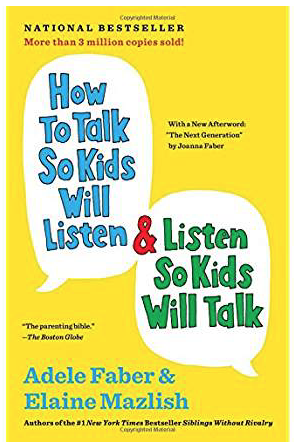We are part of Amazon Affiliates.

I have to admit something up front. I don’t read parenting books. Call it laziness or cockiness, but I’ve always had a hard time believing that one book could unlock the key to raising well-adjusted kids. I rely on my instinct; on chats with my husband, mom, and girlfriends; and I scan parenting articles on specific topics as they come up, like sleep, potty training, teething, and “does this poop look normal?”
But reading an entire book cover to cover? It’s only happened once and that honor goes to How to Talk So Kids Will Listen & Listen So Kids Will Talk by Adele Faber & Elaine Mazlish.
It was actually a reader from San Francisco Moms Blog who turned me on to this book. I heard through the grapevine about an easy technique to get toddlers to willingly brush their teeth, and I was blown away by the results, so I wrote an article about it. A reader let me know that the trick is actually from How to Talk So Kids Will Listen, and I literally ordered my copy from Amazon that day.
While the teeth brushing technique wasn’t spelled out in the book exactly as I had heard it, the concept was there, as well as tons of other ideas and concrete advice on how to communicate better with our children. The back cover of the book explains it well.
The down-to-earth, respectful approach of Adele Faber and Elaine Mazlish makes relationships with children of all ages less stressful and more rewarding… Their methods of communication… offer innovative ways to solve common problems. You’ll learn how to cope with your child’s negative feelings, express your anger without being hurtful, engage your child’s willing cooperation, set firm limits and still maintain goodwill, use alternatives to punishment, and resolve family conflicts peacefully.
Happily, my parents employed most of these techniques when raising my brothers and me so the underlying premise of the book – setting appropriate boundaries while acknowledging and respecting children’s feelings – was familiar. It was also validating to know I was on the right track with my own kids.
But please don’t let me lead you to believe that I’ve never struggled with how to get my kids to do what I need them to do. This book has given me actual phrases to say that, as if by magic, turn a situation around and get my kids and me working together to solve our problem. How to Talk So Kids Will Listen sits on my nightstand, and when I’m puzzled about how to approach an issue or need a refresher on a particular skill, I scan the book to get back on track.
Faber and Mazlish say these communication skills work for toddlers to teens (and beyond), and I have no reason to doubt them. So much of this, once you stop to think about it, is common sense. When we speak respectfully to other people, whether they’re our children or not, we tend to be treated with respect back.
I started using the techniques when my children were three and four years old, and here are a few examples of how I’ve incorporated this advice into my approach.
I use exaggeration to diffuse tension.
When my kids used to resist doing something, I’d stick to the facts. I understand you don’t want to do this, but, like it or not, this is the way it is. Now get over it and let’s go. That… rarely worked. Even if I gained compliance (and that’s a big “if), I had whiny kids who weren’t enthused about whatever it was we were going to do. Now, I play into what they wish they were doing. “I bet you wish you could stay up all night watching Paw Patrol. How many episodes do you think you could watch?” Giving into their fantasies diffuses the conflict and makes them feel heard – more so than if I only tell them I undestand. Often, that’s enough to get them moving.
I make statements instead of asking questions.
Apparently asking, “What’s wrong?” is an overwhelming question for a child. Let’s face it, most adults won’t give an honest answer to that question either. By simply stating what I see, though, I get a lot more information out of my kids. If I say, “You look like you’re thinking really hard about something,” they either correct me and tell me why I’m wrong or agree. Either way, I get insight into what’s going on. Following up with a, “Wow, that must have made you feel frustrated,” instead of, “How did you feel about that?” goes the same way. They learn names for their feelings and tell me if I got it right or wrong.
I don’t resolve their conflicts.
My kids are sixteen months apart and are now four and five years old. This book made it clear that even young children are capable of using critical thinking skills to solve their own problems, so I’ve stopped suggesting solutions to my kids’ conflicts. I state what I see, “You want the red car to go up the side of the couch, but you want it to slide down over there.” I let them each tell me more about what they want and I repeat it back to them using slightly different phrasing. Then I say, “Well, I’m sure you’ll figure it out. You’re both very smart and play together so well.” By the time I walk away, they’ve either come up with a solution to their problem or moved on to something else.
I’ve gleaned so many more helpful insights from this book that putting them down here would make an article of equal length to the book itself, but I will note one other important point. These communication skills, while highly effective when used consistently, do not guarantee you’ll never have a conflict with your kids. None of us is a robot, capable of complying 100% of the time, but by speaking to our children respectfully we are encouraging them to grow into capable adults armed with highly effective communication skills to use with their own kids and the world at large.















